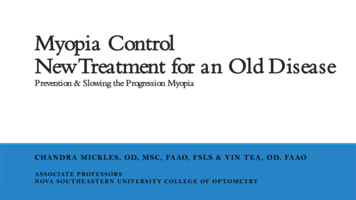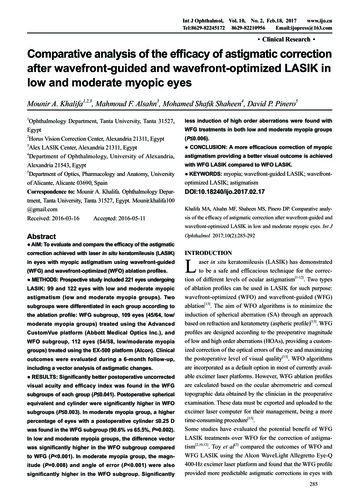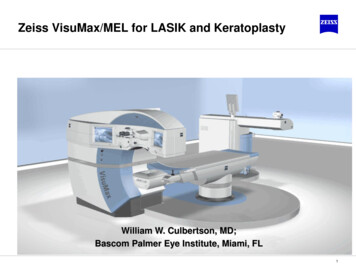
Transcription
Myopia ControlNew Treatment for an Old DiseasePrevention & Slowing the Progression MyopiaCH A N DR A M ICK LE S, O D, M SC, FA AO, F SLS & Y IN TE A , O D, FA AOA S S O C I AT E P RO F E S S O R SN OVA S O U T H E A S T E R N U N I V E R S I T Y C O L L E G E O F O P T O M E T RY
Dr. MicklesDisclosuresSpeaker, ConsultantResearch FundingAlconJ&J VisionSynergEyesTangible ScienceDr. TeaNone
Myopia Control or Not That isthe Question?5 year old maleOD 5.75-1.00x180OS -5.75-1.00x 180Distance orthoNear 2 esoBoth Parents & olderbrother are high myopes
OrthokeratologySoft MultifocalsAtropineCourtesy Melanie Frogozo,OD, rops-nearsighted-children
Having Trouble Keeping Up-to-Date?Myopia Managementwhat we know is changing at a Rapid tml
Course GoalMyopia Management .What Are theLatestDevelopments inMyopiaManagementWhat’sNew inScleralLenses?PreventionControlSuccessTips for practitionersThe Big pictureYou will be armed with the latest evidence-based strategies &recommendations to have successful outcomes with your patients
Why ShouldYou Care?Myopia is reaching epidemic levelsaround the globeIn the U.S., rates of myopia havealmost doubled in 30 years50% ofthe world population willbe myopic by 2050Image: Nature DailyVitale S, Sperduto RD, Ferris FL 3rd. Increased Prevalence of Myopia in the U.S.between 1971-1972 and 1999-2004.Arch Ophthalmol. 2009.Holden BA, et al. Global prevalence of myopia and high myopia and temporal trendsfrom 2000 through 2050. Ophthalmology. 2016A Huge Myopic Population Exist2.5 billion 2020 5 Billion 2050
Why MyopiaManagement?Myopia can result invisual devastationGreater risk of RD, maculadegeneration, glaucoma, earlyonset cataracts, peripheral retinaldegeneration, choroidal neo*Courtesy of Marco Gonzalez, MD
Why Myopia Management?Impaired Quality Of LifeIt's easy to see that it's not easy when you can't seePeople with a high myopia experience impaired qualityof life similar to that of people with keratoconus(Rose et al BJO 2000 and Takashima et al Jpn J Ophthalmol 2001)
What Are theLatestWhat’sDevelopmentsinMyopiaNew inManagement ?ScleralLenses?Prevention
MYOPIAManagement1. Prevention of myopia onsetGoal?2. Slowing myopia progressionWhat’s the
PREVENTION of myopia onsetStrongest predictors of myopia development1. Number of parents with myopia2. Amount of time spent playing outdoors
Risk Factors
Risk Factors1. Genetics2. Near work3. Outdoor play time4. Night lights5. Accommodative dysfunction
1. GeneticsThere is a strong association between number of myopicparents and the risk of childhood myopia development. Zero parents with myopia 10% risk One parent with myopia 20-25% risk Two parents with myopia 40-50% riskJones et al. Invest Ophthalmol Vis Sci. 2007;48:3524-3532
Zero Parentwith Myopia10%Jones et al. 2007
One Parentwith Myopia20%-25%Jones et al. 2007
Two Parentswith Myopia40%-50%Jones et al. 2007
2. Near WorkNO LINK found between myopia development and amount ofnear work. (Jones-Jordan et al. 2011)NO LINK found between rate of progression and amount ofnear work. (Jones-Jordan et al. 2012)
Near Work and Myopia DEVELOPMENTCLEERE Study 831 myopes / 0.75D587 emmeropes -0.25 and 1.00D Parent supplied visual activity data – 5 years before and 5 years after myopia onset Age, Sex, Ethnicity-matched Hours per week- Reading for pleasure- Using computer/playing video games- Playing outside/sports- Studying- Watching TVResults Hours of near work did not differ before myopia onset Hours of near work greater in myopes than emmetropes at onset and in 4 of 5 years after onset Hours of outdoor/sports fewer for myopes 3 years before onset and 4 years after onset Studying and TV watching not different before myopia onsetConclusions Myopia onset may influence children’s near work behavior, lack of difference before onset arguesAGAINST near work being major cause of myopia development. Outdoor activity stronger influence than near work on development of myopia.
Near Work and Myopia PROGRESSIONCLEERE Study 835 myopes / 0.75D Parent supplied visual activity data Average activity data at beginning and end of 1 yr progression intervalResults Hours of reading for pleasure not significantly associated with annual myopia progression Hours of other near activities not significantly associated with annual myopia progression Hours of outdoor/sports not significantly associated with annual myopia progression Studying and TV watching not different before myopia onset Each additional 10 hours of reading associated with small annual increase -0.08DConclusions Near work had little effect on rate of myopia progression Outdoor activity had little effect on rate of myopia progression
3. Outdoor Play TimeAmount of time spent outdoors protective against the onset ofmyopia. (Jones et al. 2007)Effect on rate of progression?(Jones-Jordon et al. 2012, Xiong 2017)Outdoor vs Indoor Vision1. Light level2. Spectral composition of light3. Dioptric topographies
Outdoor vs. Indoor Vision1. Ambient Light Level
Outdoor vs. Indoor Light LevelsOUTDOOR LIGHTINGINDOOR LIGHTING
High Ambient Light Treatment?Smith et al 2012Ashby & Schaeffel, 2010Norton & Siegwart, 2013Monkeys
Outdoor vs. Indoor Vision2. Spectral Composition
Popular Mechanics, November 25, 2012
Outdoor vs. Indoor Vision3. Dioptric TopographyCharman et al. 2011
Flitcroft et al. 2012
4. Night time lightingInitial reports of association between childhood myopia andnight-time lighting before age 2 could not be confirmed insubsequent studies. Patient population Parental myopia Families with 2 myopic parents reported using night-lightssignificantly more than families with zero or 1 myopic parent.Quinn et al. Nature 1999, Zadnik et al. Nature 2010, Gwiazda et al. Nature 2010
5. AccommodationAccommodative patterns associated with myopia Increased AC/A ratio is early sign of becoming myopic (Mutti et al. 2017) Increased accommodative lag occurs AFTER myopia onset (Mutti etal. 2006)
Adenosine Receptor Antagonists Caffeine 7-methlxanthine
Risk Factors1. Genetics2. Near work3. Outdoor play time4. Night lights5. Accommodative dysfunction
What Are theLatestWhat’sDevelopmentsinMyopiaNew inManagement?ScleralLenses?Control
MYOPIAManagementWhat’s theGoal?1. Prevention of myopia onset2. Slowing myopia progression
Controlling MyopiaINEFFECTIVE STRATEGIES1. Undercorrection2. SV Gas Permeable Contact Lenses3. Segment Bifocal or Progressive Addition LensesPROMISING TREATMENTS4. Topical Pharmaceuticals5. Executive BF and Prisms6. Ortho K and Soft BF Contact Lenses
INEFFECTIVE STRATEGIES1. Undercorrection of Myopia Hyperopic defocus promotes eye growth and myopia development. Myopic defocus limits eye growth and promotes formation of hyperopia.Question: Does undercorrection (myopic defocus) slow myopia progression?Answer: NO. Opposite effect observed. Fully corrected eyes progressedslower than under-corrected eyes (Chung et al. 2002) Under-correction may promote growth similar to mechanism indeprivation myopia that outweigh effects of myopic defocus.
1. Undercorrection of MyopiaRESULTS:Adler & Millodot (2006) 6-15 yo Undercorrected by 0.50Adler & MillodotChung et al.Chung et al.(2002) 9-14 yo Undercorrected by 0.75 Fully corrected: -0.82 D progression Undercorrected: -0.99 D progression Fully corrected: -0.77 D progression Undercorrected: -1.00 D progressionUndercorrection NOT effective tx in slowingdown progression of myopia in children.
INEFFECTIVE STRATEGIES2. Gas Permeable Contact Lenses Rigid, gas permeable lenses can mold cornea.Question: Does RGP lenses slow myopia progression?Answer: Some reduction in myopia progression but NO change in reducingaxial length (Walline et al. 2004) Since treatment effects are only corneal, effect only temporary,therefore GPCs should not be fit solely for myopia control purposes.
2. Gas Permeable Contact LensesKatz et al. (2003) 6-12 yo SV Spectacles vs. RGP 2 yearsRESULTS:Katz et al. SCL: -1.33 D RGP: -1.28 D0.84mm0.79mmWalline et al.Walline et al. (2004) 8-11 yo SV SLC vs. RGP 3 years SCL: -2.19 DRGP: -1.56 DCorneal curvature steeper for SCL groupAxial length difference not statistically differentGPCs do not slow rate of myopia progression andshould NOT be fit solely for myopia control.
INEFFECTIVE STRATEGIES3. Segment BF and PALs Myopes tend to under-accommodate at near (Gwiazda et al. 1993) This results in HYPEROPIC blur at near. Hyperopic blur drives myopia.Question: Does reducing accommodative lag with near add reduce progression?Answer: No impact of bifocals on slowing myopic progression (Grosvenor et al. 1987) Statistically significant, but clinically insignificant reduction in progression(Gwiazda et al. 2003) -0.20 over 3 years
Controlling MyopiaINEFFECTIVE STRATEGIES1. Undercorrection2. SV Gas Permeable Contact Lenses3. Segment Bifocal or Progressive Addition LensesPROMISING TREATMENTS4. Topical Pharmaceuticals5. Executive BF and Prisms6. Ortho K and Soft BF Contact Lenses
PROMISING STRATEGIES4. Topical Pharmaceuticals – Antimuscarinic agents Topical Pirenzepine was found to slow myopia progression intwo major studies 51% reduction in progression U.S. Study 77% reduction in progression Singapore Topical pirenzepine not commercially available in USA Topical Atropine is most effective, but have side effects ofblur and photophobia Prevention of myopia onset (Fang et al. 2010) Slows progression of myopia (Chua et al. 2006, Wu et al. 2011)
4. Topical Pharmaceuticals – antimuscarinic agentsFang et al. (2010) 0.025% Atropine Progression and Onset 1 yearRESULTS:Fang et al. Atropine: -0.14 D 21% onset Control: -0.58 D 54% onsetChia et al.Chia et al. (2016) ATOM Studies 0.5%, 0.1%, 0.01% Atropine Phase 1, 2, 3 5 years Phase 1 – Greater effect in higher dose withinverse effect during washout, so 0.01% bestover 3 years Phase 2 – Restarted on Atropine 0.01%24% 59% 68% Phase 3 – Progression and axial elongationlowest in 0.01% group after 5 years.
Atropine DosageFang et al. 0.025Chia et al. 0.500 0.100 0.010 **Yam et al. 0.050 ** 0.025 0.010Yam et al. 2019 (LAMP Study)Conclusions:The 0.05%, 0.025%, and 0.01% atropine eyedrops reduced myopia progression along aconcentration-dependent response. Allconcentrations were well tolerated without anadverse effect on vision-related quality of life. Ofthe 3 concentrations used, 0.05% atropine wasmost effective in controlling SE progression andAL elongation over a period of 1 year.Ophthalmology 2019;126:113-124
PROMISING STRATEGIES5. Executive Bifocals with Prism Some effect in slowing progression of myopia found with 1.50 Executive BF and 3BI Prism (Cheng et al. 2010 and 2014)
5. Executive Bifocals with Prism3 year study8-13 yr oldsProgression of at least -0.50 per yearRESULTS:① SV:② BF:③ BFP:-2.06D 0.82mm-1.25D 0.57mm-1.01D 0.54mm① SV lenses② 1.50 BF③ 1.50 BF with 3BI (BFP) Both BF groups better than SV Lag of Accommodation Near Phoria Status Amount of progression Axial length High lag: BF and BFP no different Low lag: BFP better than BF(Cheng et al. 2010 and 2014)
PROMISING STRATEGIES6. Multifocal ContactLenses andOrthokeratology
OrthokeratologyContactLensesORSoft Multifocals
Ortho-KSlowing the Progression of Myopia with CLsNearPeripheral hyperopic defocus accelerates axial growthCenter-Distance*Peripheral myopic defocus can reduce axial growth*Relative Plus (Myopic Defocus)Soft MultifocalOrtho-k and soft multifocals inhibit myopia progression by inducing peripheral retinal myopic defocus*.www.reviewofoptometry.com/continuing education/tabviewtest/lessonid/106321/Images CooperVision ,Alcon, Paragon fitting guidesCourtesy of these manufacturers
Ortho-K or Soft Multifocals?5 year old maleOD-5.75-1.00x180OS -5.75-1.00x 180Distance orthoNear 2 esononathleteDenies allergies or dry eyePupil size 4.5 mm normal illumination
Is Ortho-K OK?Ideal Candidates for myopia controlLarge pupilsMyopes 6D of sphereChildren unable to wear softs CLs due to allergiesAthletes
OrthokeratologyIdeal Candidates Larger pupils facilitate the myopia control outcomeThe peripheral myopic defocus will lie in the pupilThe peripheral myopic defocus will lie outside ofthe pupil for small pupils & will limitthe efficacy of myopia controlArea of Peripheral Myopic DefocusTreatment zoneThe average treatment zone for OK is 3.5 mm with 1.5 to 2.0 mm zone ofperipheral myopic defocus so a 5mm pupil ( 3.5 1.5 mm ) is idealAbove pupil is too smallChen Z et al. Impact of pupil diameter on axial growth in orthokeratology. Optom Vis Sci. 2012Smith EL 3rd. Optical treatment strategies to slow myopia progression: effects of the visual extent ofthe optical treatment zone. Exp Eye Res. 2013
OrthokeratologyIDE A L CA N DIDAT E SMyopes with up to 6.00D of sphere*The FDA approval for ortho-k:Temporary reduction of myopia up to –6D of sphere withup to 1.75 D of WTR, 0.75 ATR astigmatism *Attempting to correct greater than 4.00Dincreases the risk of central staining (Liu 2016)High levels of correction ( 4.00D) also increasesthe risk of a decentered lens and treatment zone.Spherical corneal GP on high toric corneaHigh Cyl 1.75 D is not ideal unless you have a toric ortho-K optionCourtesy of Christine Sindt OD and Melanie Frogozo OD*Ortho-K is Approved for all ages not myopiacontrolLiu YM, Xie P. The Safety of Orthokeratology—A Systematic Review. Eye Contact Lens. 2016 Jan
OrthokeratologyIdeal CandidatesAthletes especially swimmers
Orthokeratology OptionsWaveMany more .
Is Ortho-KBest?NonathleteDenies allergies5 yo oldmaleDistanceorthoNear 2 eso-5.751.00x180OD, OS
Soft MultifocalsIdeal CandidatesoResponsible enough to wear lenses during the dayoLow and high myopesOrtho-K can be more challenging to fit( 5D)oLow astigmatsVery limited reusable soft multifocal toric optionsNo daily disposable multifocal toric option
Soft Multifocals?5 yomaleVery matureFor age-5.75-1.00x180OD, OSCorneal Plane-5.50-0.75x180NonathleteDenies allergiesDistanceorthoNear 2 eso
Soft Multifocal Options“D” Lens OUCooperVisionJ&J VisionCurrently recommendation is *Center-Distance for effective myopia control
Soft Multifocals: ADDA. 1.00DB. 1.50DC. 2.00DD. 2.50DBerntsen and Kramer 2013Walline et al 2013
Soft Multifocals: When the ADD is Too MuchIf the add power creates issueThe best 1st option is to .-5.00 DS 2.50 ADDAdd more minus to the spherical powerReduce the AddOR-5.00DS 2.00 ADD-5.50 DS 2.50 ADDWalline 2017
Newer Daily Disposable Multifocal OptionsCooperVision (Not available in U.S.)Visioneering TechnologiesMarketed specifically for myopia managementLaunched in Canada 2018Both Center-Distance designs
Coming SoonSYNERGEYESEXTENDEDDEPTH OF FOCUS(EDOF) LENS
Outcome8 yomale-5.00-1.00x178OD, OSStable VADistanceorthoNear 4 exoGood PFVSE: -6.25 at 5yo to -5.50 at 8 yoNo Significant Myopic Progression!
Which is the most effective option?Ortho-K70-80%45%Side effects:Blurred visionPhotosensitivity*Yen Fang Chua ShihSoft Multifocal38%Orth-K and soft multifocals have similar efficacy *Slightly better efficacy with concentricring design than aspheric designHiraoka KakitaChoWallineSankaridurg Walline AnsticeAller
Aspheric designConcentric RingMiSight 1 DayWhich soft design?Image Credit Dinardo A, Rosen C . CLS 2017
Treatment zones create myopic defocus.Two correction zones that helps correct myopia in all gaze positions.Children can see clearly while slowing their myopia progressionConcentric Ring3 year findings 60%less myopia progressionMiSignt 1DayImage credit CooperVision MiSight 1 Day
Which contact lensmyopia control option isthe safest?The risk of MK.Overnight Ortho-K daily wear of reusable soft*Daily disposable wear soft reusableChildren (aged 8-12) have a lower rate of infection thanteens & adultsAttributed to better compliance & closer parentalsupervisionBullimore MA 2017 ; Wagner H et al 2014Safer Than You ThinkLow Risk of CL-relatedinflammatory events
Benefits ofmyopia controloutweigh the risks ofdaily wear of contactlensesBU L L I M O R E , M . R I T C H E Y E R I C. PA P E RP R E S E N T E D AT A M E R I C A N AC A D E M Y O FO P TO M E T RY 2 0 1 9Years of uncorrectable visual impairment that may be prevented by lowering patients’ultimate level of myopia was compared to the corresponding years of visual impairment(from MK) associated with 5-years of CL wear
Which Optionis preferred byparents?(0)Ortho-KSoft MF Bifocal glasses Eye dropsN 196, 3 University SitesMeyer, Mickles, Cox. Parents Perceptions of Myopia Control. IOVS 2016.abstractCheung et al 2014.Optom Vis Science 2014.
Corneal GP toric ortho-KCorneal GP multifocalsScleral GP multifocalsHybrid MultifocalsOrtho-K Scleral(concerns of corneal swellingNo study showing effective in myopiacontrol/large treatment zoneMyopia reduction up to 6D)Chen et al. Myopia control using toricorthokeratology (TO-SEE-STUDY).IOVS 2013N 80Toric ortho-k lenses were effective (52%slower) in slowing myopia for childrenwith moderate-to-high astigmatism)4D of cylFadel D. Ortho-: The Future fitting of scleral lenses ? Presented at GSLS 2017Fadel D. Herzberg C. Is Ortho-K possible with corneo-scleral lenses. CLS 2016Yin Li. Off-label use of scleral contact lens for orthokeratology following an unsuccessfulcorneal gas permeable fit. Poster presented at GSLS e-box/4.5 D of cyl
OrthokeratologyIDE A L CA N DIDAT E SWhat about High Myopes?Myopes with less than 6.00D of sphere*Attempting to correct greater than 4.00D linkedwith increased corneal staining (Liu 2016)High levels of correction ( 4.00D) also increasesthe risk of a decentered lens and treatment zone.The FDA approval for ortho-k:Temporary reduction of myopia up to –6 D of spherewith up to 1.75 D of astigmatism htmlhttps://www.opticianonline.net/cet-archive/140
Some treat Max 4D with ortho-KAny residual refractive error is corrected with specsPartial reduction OK effectively slowed myopiaprogression in high myopes 6D63% slower than the control group (Charm, Cho 2013)More studies are neededPartial Ortho-K maybe OKCharm J, Cho P. High myopia-partial reduction orthokeratology (HM-PRO): study design. Cont Lens Anterior Eye. 2013 box/
Clever CombosSoft MultifocalsBifocal & Atropine in Myopia (BAM) Study(Biofinity Multifocal & 0.01% Atropine).OngoingOrtho-KSoft MultifocalsBifocal Spectacles70% reduction in children with esophoriaAller et al. /0.025% atropine Ortho-K was 53% more effective than Ortho-K aloneMore effective with lower amounts 6D of myopia Wan L et al. 20180.01% atropine Ortho-K was 50% more effective than Ortho-K aloneKinoshita et al 2017Combined Atropine With Orthokeratology in Childhood MyopiaControl (AOK)-A. Ongoing
Management Options
What Are theLatestWhat’sDevelopmentsinMyopiaNew inManagement?ScleralLenses?Measuring Success
Clinically meaningful myopia control1. Refractive error 0.50 D per year 0.1mm 50% reduction2. Axial length 0.1mm to 0.2mm per yearZhao et al. 2002
MYOPIACONTROLTools of the Trade
Tools1. Axial length measures Contact biometry Non-contact metry-applanation-technique
Tools2. Refractive Error Cycloplegic autorefraction Open field autorefractor Measures both eyes at the same time Open view window allows you to choose target Can measure peripheral /auto-ref-kerato-meter-wam-5500/
When shouldWe Stop?
Age to Discontinue Myopia Control8 yomale-5.00-1.00x178OD, OS2019Little evidenceon when it isappropriate tostop myopia controlSuggested to continue myopia controlat least through the age during whichtheir myopia is expected to progress(age 15 or 16)2027
A rebound effect has been shown with 1% atropineSmall rebound effect with low concentration atropineMaybe a rebound effect with Ortho-KNo evidence of rebound effect with soft multifocalsReboundEffectMore studies are neededChia A, et al. Atropine for the treatment of childhood myopia:changes after stopping atropine 0.01%, 0.1% and 0.5%.Am J Ophthalmol. 2014Swarbrick HA et al. Myopia control during orthokeratologylens wear in children using a novel study design. Ophthalmology. 2015Cheng X, et al. Soft Contact Lenses with PositiveSpherical Aberration for Myopia Control. Optom Vis Sci. 2016
What AreYouWaitingFor ?
What nueSafeParents AreInterestedControl of myopia may become the standard of care
Parents Are Interested70% of parentswanted to pursuemyopia controlwere unaware ofmyopia control &complications of highmyopiaParents Perceptions of Myopia and Myopia ControlMeyer, Mickles, Cox, Kollbaum ARVO, AAO 2016196 subjects, 3 University SitesCheung et al. 2014
piacontrol.orgManagemyopia.orgOffer communication tools to help parents understand myopiaand the steps that they can take to help their children
CommunicationToolsMyopiaprofile.com
Myopiaprofile.com
Brien Holden Vision Institute CalculatorDemonstrates the possible benefits over time of treating myopia progressionDiscuss risk versus benefit with patientsPatientEducationEvidence-based
Primary Myopia Control Method40%11%I don't utilize myopiacontrol in my practice5%39%Soft Multifocal20%Ortho-K25%Pharmaceutical AgentWhat AreA combinationBennett, Barnett, Paul. Contact Lens Spectrum 2019Audience of lecture attendees at Optometry’s Meeting 2018What AreWeWaitingFor?You Waiting For ?
Biggest Challenge to incorporatingMyopia controlIn particular Ortho-K12Expense to the patientComplex fitting/Learning Curve52%26%Other reason: Limited number of patients who would benefitBennett, Barnett, Paul. Contact Lens Spectrum 2019Attendees polled at Optometry’s Meeting Lecture
Having Trouble Keeping Up-to-Date?What Are You Waiting For?Getting Up to SpeedContinuing EducationVision by Design conferenceGlobal Specialty Lens SymposiumManaging Myopia CE Program (Brien Holden Institute)Gas Permeable Lens Institute WebinarsCL ManufacturersInfo to train O.D.s to learn how to fit their lens designsStreamlined the fitting process & training troubleshooting cardsMyopia progression control patient ed toolsSuccess is in ReachNationwide, multi-center study determined that the 1st-fit success withempirically designed ortho-K lenses was greater than 80%innovationis changingaSMART ace.htmlStabilizing Myopia by Accelerating Reshaping Technique (SMART) study.
The International MyopiaInstitutecreated a DEWS like reportIOVS. February 2019www.myopiainstitute.orgwww.myopiainstitute.org
Tips forPractitioners
Create A Consent FormPoints to ConsiderMyopia control is not FDA Approved*Myopia control is off-labelOrtho-K is FDA approved for myopia reduction, NOTmyopia controlPotential ComplicationsAbrasions, infections etc.Potential Complications-What to DoReturn to Eye Doctor ASAPCareAvoiding water, etc.Financial policyFitting and fees are non-refundableSide effects (Atropine)Avoidance of other rials/informedconsent/default.htm
Myopia Control SelectionChoose a myopia control option that best fits the patient’sand parent’s lifestyle“Contacts Heck NO”!Ineffective if not goingto use managementTry other myopia control optionsi.e. Low dose atropine
Monitor CloselyCycloRefractionAxiallengthBV &Accommodativetesting
THEMyopiaManagement
Increasing prevalence& Detrimental Impact
thinkaboutreducingmyopiaSight is a gift
Myopia Management .What Are theLatestDevelopments inMyopiaManagement?PreventionWhat’sNew inScleralLenses?ControlSuccessTips for practitionersThe Big picture\
Improve Future LivesEarly detection & interventionReduce the impact of myopia onocular health & quality of lifehttps://www.truesmarttechnologies.com/college training.html
Drs. Mickles & Teacmickles@nova.eduyintea@nova.edu
Near Work and Myopia DEVELOPMENT CLEERE Study 831 myopes / 0.75D 587 emmeropes -0.25 and 1.00D Parent supplied visual activity data -5 years before and 5 years after myopia onset Age, Sex, Ethnicity-matched










